Module 5 Lao She's Teahouse.Unit 3 Language in use.探究导学课型课件
文档属性
| 名称 | Module 5 Lao She's Teahouse.Unit 3 Language in use.探究导学课型课件 | 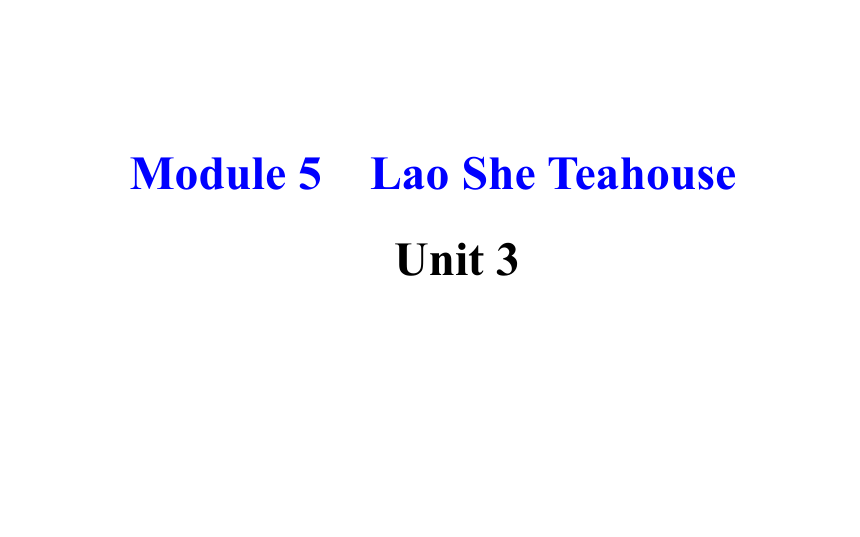 | |
| 格式 | zip | ||
| 文件大小 | 1.4MB | ||
| 资源类型 | 教案 | ||
| 版本资源 | 外研版 | ||
| 科目 | 英语 | ||
| 更新时间 | 2017-10-17 15:17:31 | ||
图片预览

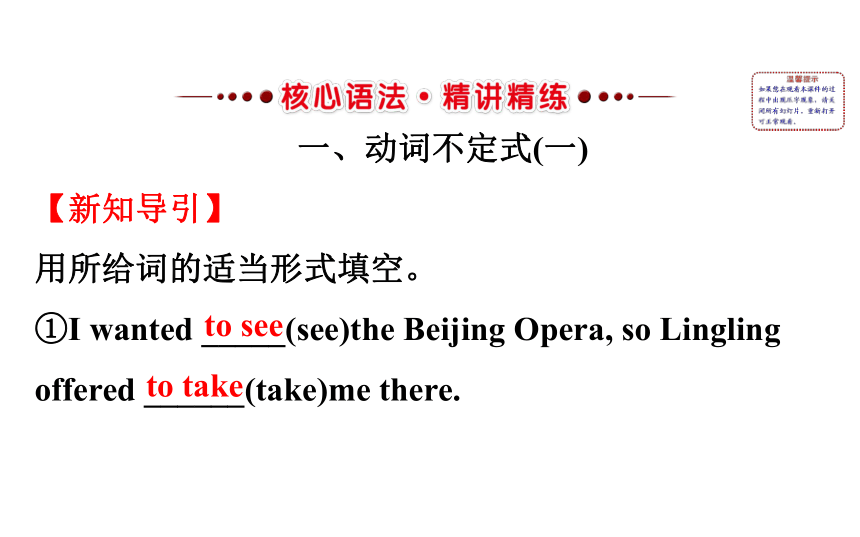
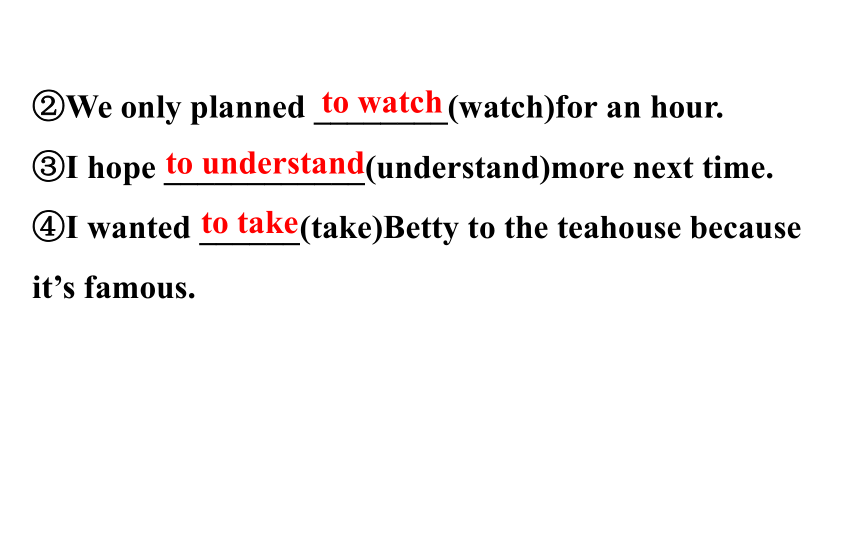
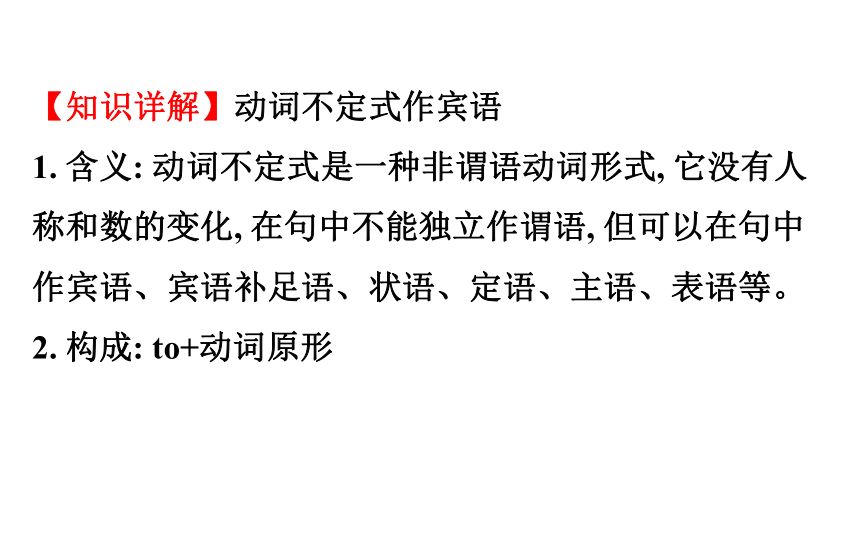
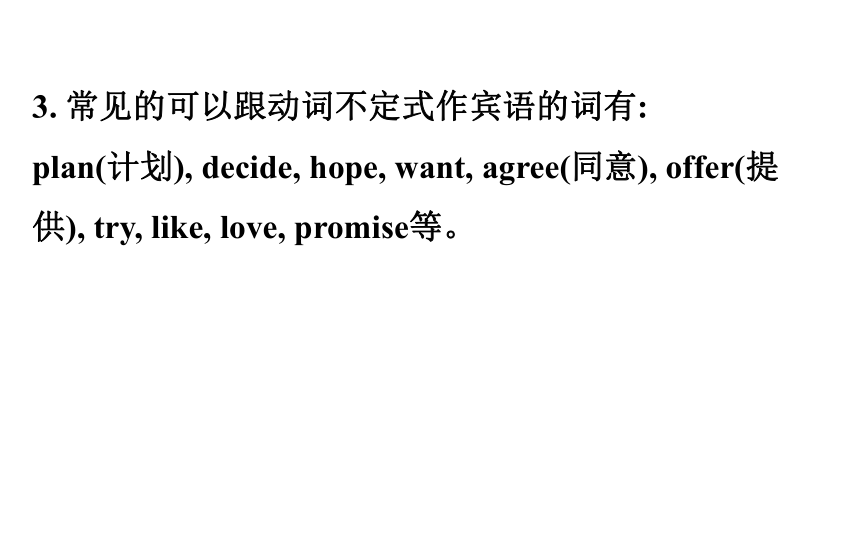


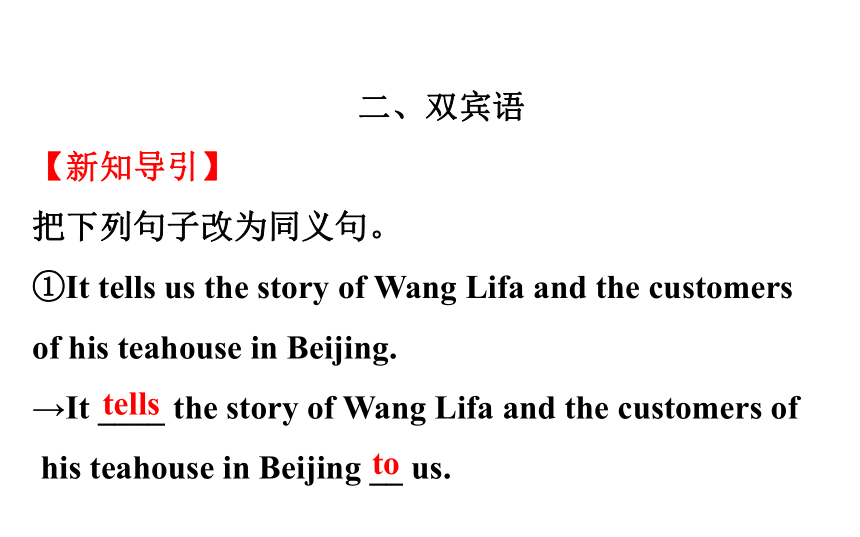
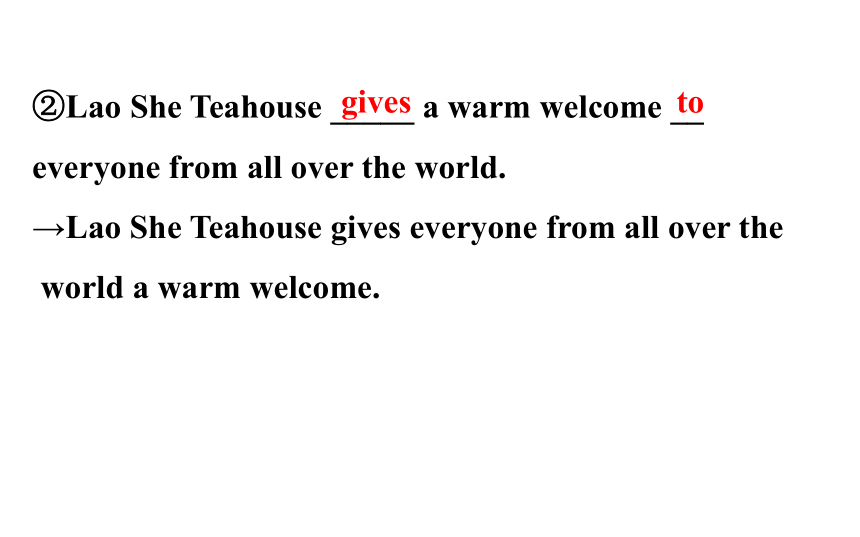
文档简介
课件29张PPT。Module 5 Lao She Teahouse
Unit 3 一、动词不定式(一)
【新知导引】
用所给词的适当形式填空。
①I wanted _____(see)the Beijing Opera, so Lingling
offered ______(take)me there. to seeto take②We only planned ________(watch)for an hour.
③I hope ____________(understand)more next time.
④I wanted ______(take)Betty to the teahouse because
it’s famous. to watchto understandto take【知识详解】动词不定式作宾语
1. 含义: 动词不定式是一种非谓语动词形式, 它没有人称和数的变化, 在句中不能独立作谓语, 但可以在句中作宾语、宾语补足语、状语、定语、主语、表语等。
2. 构成: to+动词原形3. 常见的可以跟动词不定式作宾语的词有:
plan(计划), decide, hope, want, agree(同意), offer(提供), try, like, love, promise等。【即学活用】
用所给动词的适当形式填空。
①Mum, I decide ______(buy)a new bag. Do you agree
with me?
②Some of the young girls hope _____(be)famous
someday. to buyto be③Mr Green is planning ________(travel)to Beijing
next week.
④Could you tell me how _________(answer)the
question?
⑤Today the company offers ______(help)the poor
family. to travelto answerto help二、双宾语
【新知导引】
把下列句子改为同义句。
①It tells us the story of Wang Lifa and the customers
of his teahouse in Beijing.
→It ____ the story of Wang Lifa and the customers of
his teahouse in Beijing __ us. tellsto②Lao She Teahouse _____ a warm welcome __
everyone from all over the world.
→Lao She Teahouse gives everyone from all over the
world a warm welcome. givesto【知识详解】双宾语
1. 定义: 有些及物动词后可接两个宾语, 一个指人, 叫间接宾语, 另一个指事物, 叫直接宾语, 这种“动词+人+事物”的结构称为双宾语结构。2. 双宾语的两种形式:
(1)动词+间接宾语(某人)+直接宾语(某物)
(2)动词+直接宾语(某物)+ to/for +间接宾语(某人)3. 常用词: 可以接双宾语的动词很多, 常见的有:
(1)常见可以用介词to进行转换的动词有: bring, teach, lend, send, give, tell, sell, pass, show, offer等。
(2)常见可以用介词for进行转换的动词有: buy, get, make, cook, read等。【即学活用】
①你什么时候把自行车还给我?
When will you ______ my bike __ me?
②请把这本词典给我。
Please ____ the dictionary __ me. returntogiveto③昨天我妈妈给我们做了面条。
Yesterday my mother _______ _______ ___ us.
④大明把他的自行车借给了我。
Daming ____ ___ his bike.
⑤老师给我们讲了一个有趣的故事。
The teacher ____ __ an interesting story. cookednoodlesforlentmetoldus【话题剖析】
本模块的话题是戏剧和电影。在写这类作文时, 首先要对人物或故事内容进行梳理。对事情发生的时间、地点、涉及的人物和经过要进行描述。注意写作时, 要注意时态和人称的运用。【素材积累】
★词汇积累
1. 提议; 提出 _____ 2. 描述 ________
3. 给……命名 _____ 4. 展示 _____
5. 结束 ____ 6. 第二十 _________offerdescribenameshowendtwentieth★短语积累
1. 发生 _________ 2. 最后 _________
3. 把某人送到…… ____________
4. 出生 _______
5. ……之一 ________ 6. 回到 ________
7. 使某人做某事 ______________
8. 告诉某人某事 __________take placein the endsend sb. to. . .be bornone of. . .return tomake sb. do sth.tell sb. sth.★句子积累
1. 我最喜欢的戏剧是老舍的《茶馆》。
My ________ ____ is Teahouse by Lao She.
2. 他是中国最著名的作家之一。
He is ____ __ the _____ _______ _______ in China.
3. 我的家乡发生了许多变化。
Many changes ____ _____ in my home town. favouriteplayoneofmostfamouswriterstookplace4. 琳达把她的猫送到了她朋友的家。
Linda ____ her cat __ her friend’s home.
5. 最后, 我们打败了他们赢得了比赛。
__ ___ ____, we beat them and won the match. senttoIntheend【实战演练】
以“My favourite TV play”为题目, 向大家介绍你最喜欢的一部电视剧《锦绣未央》(The Princess Weiyang)。 要求: 80个词左右。
提示: 1. 她本是北凉国一个幸福的公主;
2. 到了北魏, 成为李未央;
3. 帮助拓跋浚成为皇帝;
4. 成为一个王后。
参考词汇: princess公主 king国王 queen王后
Northern Liang北凉 Northern Wei北魏 ★审题谋篇
(1)时态: 主要使用一般过去时
(2)人称: 使用第三人称和第一人称
(3)模板: ★妙笔成篇
My favourite TV play is The Princess Weiyang.
This is a story about a princess called Xiner in
Northern Liang. The story took place over 1, 600 years
ago. She had to go to Northern Wei because of the war.
And she became Li Weiyang, who saved her. Then she
fell in love with Tuoba Jun, and helped him become a king. So in the end, she became a good queen. Everyone says it is one of the most interesting TV plays in China. 【方法技巧】
本模块的话题是“戏剧和电影”。在这一模块中, 我们学习了老舍、老舍的《茶馆》以及老舍茶馆的简介。运用所学知识, 写一篇短文介绍一部戏剧或电影是本模块的写作任务。Ⅰ. 写此类文章时的注意事项:
1. 开篇提出自己最喜欢的电影或戏剧, 并描述其主要内容。
2. 详细介绍故事发生的时间、地点、涉及的人物以及故事发展的过程和结局。
3. 最后对电影或戏剧作出整体评价。4. 写作过程中, 还要注意表示时间的词汇的使用, 使剧情有跨度。Ⅱ. 写此类文章时的主要句式:
1. My favourite film is Love Me Once Again, Mum.
我最喜欢的电影是《妈妈再爱我一次》。
2. This film is about a mother and a son.
这部电影是关于一个妈妈和一个儿子的。3. The story took place many years ago.
故事发生在很多年以前。
4. 18 years later, the son found his mother.
18年以后, 这位儿子找到了他的妈妈。
5. In the end, the mother got to know her son.
最后, 这位妈妈认出了儿子。
Unit 3 一、动词不定式(一)
【新知导引】
用所给词的适当形式填空。
①I wanted _____(see)the Beijing Opera, so Lingling
offered ______(take)me there. to seeto take②We only planned ________(watch)for an hour.
③I hope ____________(understand)more next time.
④I wanted ______(take)Betty to the teahouse because
it’s famous. to watchto understandto take【知识详解】动词不定式作宾语
1. 含义: 动词不定式是一种非谓语动词形式, 它没有人称和数的变化, 在句中不能独立作谓语, 但可以在句中作宾语、宾语补足语、状语、定语、主语、表语等。
2. 构成: to+动词原形3. 常见的可以跟动词不定式作宾语的词有:
plan(计划), decide, hope, want, agree(同意), offer(提供), try, like, love, promise等。【即学活用】
用所给动词的适当形式填空。
①Mum, I decide ______(buy)a new bag. Do you agree
with me?
②Some of the young girls hope _____(be)famous
someday. to buyto be③Mr Green is planning ________(travel)to Beijing
next week.
④Could you tell me how _________(answer)the
question?
⑤Today the company offers ______(help)the poor
family. to travelto answerto help二、双宾语
【新知导引】
把下列句子改为同义句。
①It tells us the story of Wang Lifa and the customers
of his teahouse in Beijing.
→It ____ the story of Wang Lifa and the customers of
his teahouse in Beijing __ us. tellsto②Lao She Teahouse _____ a warm welcome __
everyone from all over the world.
→Lao She Teahouse gives everyone from all over the
world a warm welcome. givesto【知识详解】双宾语
1. 定义: 有些及物动词后可接两个宾语, 一个指人, 叫间接宾语, 另一个指事物, 叫直接宾语, 这种“动词+人+事物”的结构称为双宾语结构。2. 双宾语的两种形式:
(1)动词+间接宾语(某人)+直接宾语(某物)
(2)动词+直接宾语(某物)+ to/for +间接宾语(某人)3. 常用词: 可以接双宾语的动词很多, 常见的有:
(1)常见可以用介词to进行转换的动词有: bring, teach, lend, send, give, tell, sell, pass, show, offer等。
(2)常见可以用介词for进行转换的动词有: buy, get, make, cook, read等。【即学活用】
①你什么时候把自行车还给我?
When will you ______ my bike __ me?
②请把这本词典给我。
Please ____ the dictionary __ me. returntogiveto③昨天我妈妈给我们做了面条。
Yesterday my mother _______ _______ ___ us.
④大明把他的自行车借给了我。
Daming ____ ___ his bike.
⑤老师给我们讲了一个有趣的故事。
The teacher ____ __ an interesting story. cookednoodlesforlentmetoldus【话题剖析】
本模块的话题是戏剧和电影。在写这类作文时, 首先要对人物或故事内容进行梳理。对事情发生的时间、地点、涉及的人物和经过要进行描述。注意写作时, 要注意时态和人称的运用。【素材积累】
★词汇积累
1. 提议; 提出 _____ 2. 描述 ________
3. 给……命名 _____ 4. 展示 _____
5. 结束 ____ 6. 第二十 _________offerdescribenameshowendtwentieth★短语积累
1. 发生 _________ 2. 最后 _________
3. 把某人送到…… ____________
4. 出生 _______
5. ……之一 ________ 6. 回到 ________
7. 使某人做某事 ______________
8. 告诉某人某事 __________take placein the endsend sb. to. . .be bornone of. . .return tomake sb. do sth.tell sb. sth.★句子积累
1. 我最喜欢的戏剧是老舍的《茶馆》。
My ________ ____ is Teahouse by Lao She.
2. 他是中国最著名的作家之一。
He is ____ __ the _____ _______ _______ in China.
3. 我的家乡发生了许多变化。
Many changes ____ _____ in my home town. favouriteplayoneofmostfamouswriterstookplace4. 琳达把她的猫送到了她朋友的家。
Linda ____ her cat __ her friend’s home.
5. 最后, 我们打败了他们赢得了比赛。
__ ___ ____, we beat them and won the match. senttoIntheend【实战演练】
以“My favourite TV play”为题目, 向大家介绍你最喜欢的一部电视剧《锦绣未央》(The Princess Weiyang)。 要求: 80个词左右。
提示: 1. 她本是北凉国一个幸福的公主;
2. 到了北魏, 成为李未央;
3. 帮助拓跋浚成为皇帝;
4. 成为一个王后。
参考词汇: princess公主 king国王 queen王后
Northern Liang北凉 Northern Wei北魏 ★审题谋篇
(1)时态: 主要使用一般过去时
(2)人称: 使用第三人称和第一人称
(3)模板: ★妙笔成篇
My favourite TV play is The Princess Weiyang.
This is a story about a princess called Xiner in
Northern Liang. The story took place over 1, 600 years
ago. She had to go to Northern Wei because of the war.
And she became Li Weiyang, who saved her. Then she
fell in love with Tuoba Jun, and helped him become a king. So in the end, she became a good queen. Everyone says it is one of the most interesting TV plays in China. 【方法技巧】
本模块的话题是“戏剧和电影”。在这一模块中, 我们学习了老舍、老舍的《茶馆》以及老舍茶馆的简介。运用所学知识, 写一篇短文介绍一部戏剧或电影是本模块的写作任务。Ⅰ. 写此类文章时的注意事项:
1. 开篇提出自己最喜欢的电影或戏剧, 并描述其主要内容。
2. 详细介绍故事发生的时间、地点、涉及的人物以及故事发展的过程和结局。
3. 最后对电影或戏剧作出整体评价。4. 写作过程中, 还要注意表示时间的词汇的使用, 使剧情有跨度。Ⅱ. 写此类文章时的主要句式:
1. My favourite film is Love Me Once Again, Mum.
我最喜欢的电影是《妈妈再爱我一次》。
2. This film is about a mother and a son.
这部电影是关于一个妈妈和一个儿子的。3. The story took place many years ago.
故事发生在很多年以前。
4. 18 years later, the son found his mother.
18年以后, 这位儿子找到了他的妈妈。
5. In the end, the mother got to know her son.
最后, 这位妈妈认出了儿子。
同课章节目录
- Module 1 How to learn English
- Unit 1 Let's try to speak English as much as possi
- Unit 2 You should smile at her.
- Unit 3 Language in use .
- Module 2 My home town and my country
- Unit 1 It's taller than many other buildings.
- Unit 2 Cambridge is a beautiful city in the east o
- Unit 3 Language in use .
- Module 3 Sports.
- Unit 1 Nothing is more exciting than playing tenni
- Unit 2 This year we training more carefully.
- Unit 3 Language in use .
- Module 4 Planes, ships and trains .
- Unit 1 He lives the farthest from school.
- Unit 2 What is the best way to travel.
- Unit 3 Language in use .
- Module 5 Lao She Teahouse.
- Unit 1 I wanted to see the Beijing Opera.
- Unit 2 It descibes the changes in Chinese society.
- Unit 3 Language in use .
- Module 6 Animals in danger.
- Unit 1 It allows people to get closer to them .
- Unit 2 The WWF is working hard to save them all.
- Unit 3 Language in use .
- Revision module A
- Module 7 A famous story
- Unit 1 Alice was sitting with her sister by the ri
- Unit 2 She was thinking about her cat.
- Unit 3 Language in use .
- Module 8 Accidents
- Unit 1 While the car were changing to red, a car s
- Unit 2 I was trying to pick it up when it bite me
- Unit 3 Language in use .
- Module 9 Population
- Unit 1 The population of China is about 1.37 billi
- Unit 2 Arnwick was a city with 200,000 people.
- Unit 3 Language in use .
- Module 10 The weathe
- Unit 1 It might snow.
- Unit 2 The weather is fine all year round.
- Unit 3 Language in use .
- Module 11 Way of life
- Unit 1 In China ,we open a gift later.
- Unit 2 In England, you usually drink tea with milk
- Unit 3 Language in use .
- Module 12 Help
- Unit 1 What should we do before help arrives?
- Unit 2 Stay away from windows and heavy furniture.
- Unit 3 Language in use .
- Revision module B
